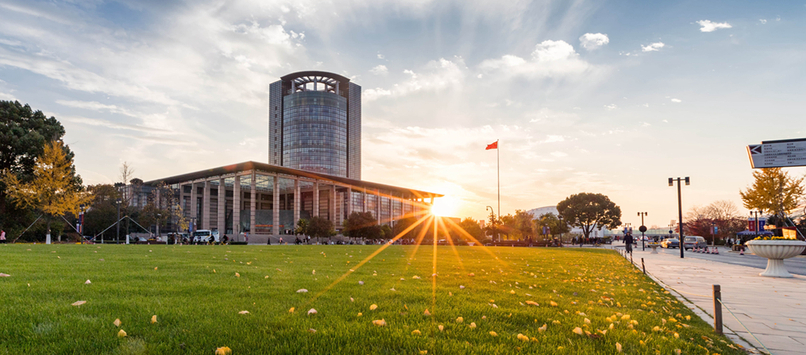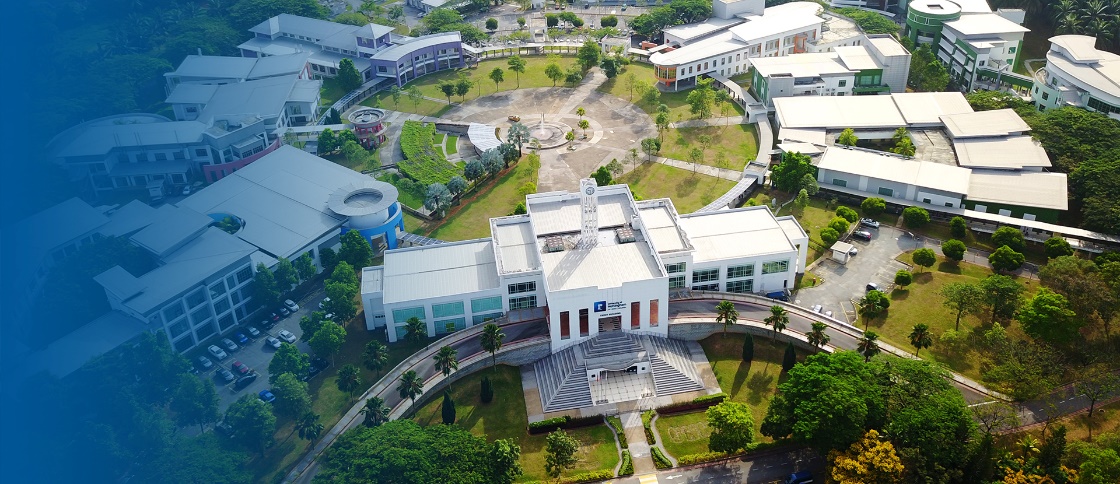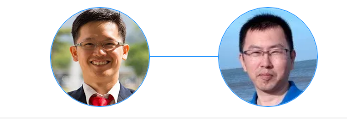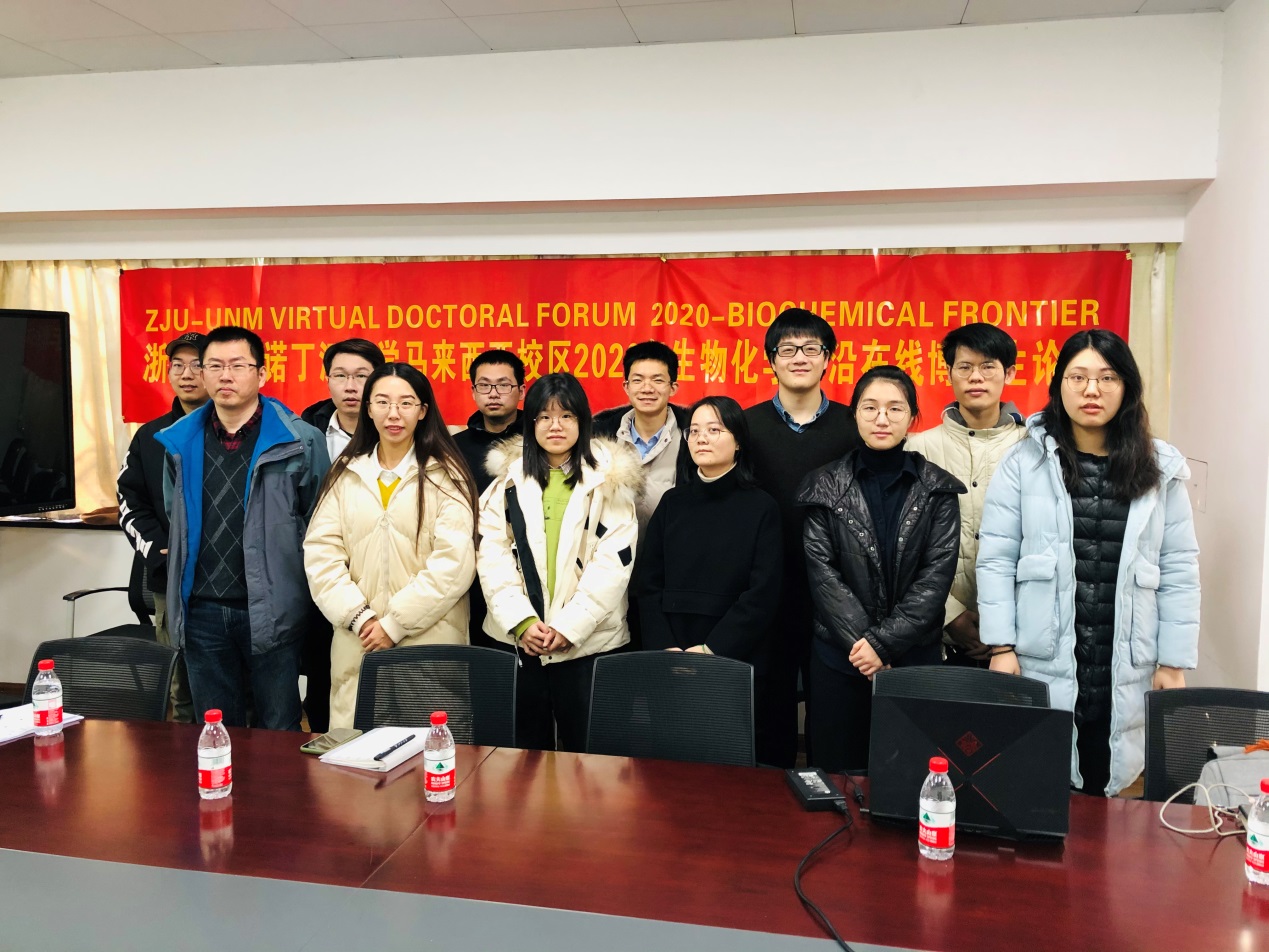March 8, 2021
ZJU-UNM Virtual Doctoral Forum 2020
Between December 30 and 31, 2020, the second academic forum (ZJU-UNM Virtual Doctoral Forum 2020) for graduate students of Zhejiang University and University of Nottingham Malaysia is held on schedule. Four scholars and twenty students from both sides gave their academic reports according to their research findings at the forum. The contents involved microalgae biomass, liquid three phase flotation system, recovery of α-2b Human Interferon from recombinant E.coli and other relevant biochemical studies.

This forum is themed as “Biochemical Frontier”. This forum invites outstanding doctoral students from Zhejiang University (China) and University of Nottingham (Malaysia campus) to share their research in the progress and frontier of technology in the field of Biochemical Engineering. The goals of the forum is to promote knowledge exchange and future collaboration between both universities, lecturers, and postgraduate students.


Under the tendency of rapid development in biomedicine, Professor Lin Dongqiang thought highly of continuous manufacturing and Pharmacy 4.0. Continuous production could promote the miniaturization of equipment, improve the productivity and reduce the cost. What’s more, Bioprocess 4.0 is introduced to integrate model and artificial intelligence to realize optimal control and promote the industrial realization of continuous biological manufacturing in response to the high difficulty ofprocess optimization.
Professor Pau-LokeShow introduced the latest development of biorefinery technology in algae research, including the use of extraction technology, such as extraction fermentation, extraction biotransformation, liquid two-phase system, liquid two-phase flotation system and the newly developed ultrasonic, microwave, electric and auxiliary liquid two-phase flotation system, process optimization, achieving the best conditions for microalgae protein extraction.
Jing Shuying introduced the technology of separation and enrichment of McAb charge heterogeneity by cation exchange continuous flow chromatography under a use of a new type of double column continuous flow chromatography. After process optimization, four kinds of acidic charge heterogeneity were obtained, and the yield reached 96%.
Khoo Kuan shiong introduced the technology of osmotic extraction of bioactive compounds from red coccidia Yunsheng and solid-liquid extraction technology of the ionic liquid prawn penicillin of carbon dioxide alkylcarbamate. After the optimization of the process, a sustainable extraction system was developed, which made the astaxanthin yield higher and the antioxidant capacity of the extracted astaxanthin was well preserved.
The research group of Zhang Wei developed a new micellar delivery cooperative system (PPPM). The surface of the micelles was modified with checkpoint peptide PDL1, with Paclitaxel (PTX) encapsulated in the micelles. PPPM PTX releases PTX to tumor site by responding to Reactive Oxygen Species (ROS) in tumor microenvironment. At the same time, checkpoint peptides on micelles can block pd-l1-pd-1 axis, thus achieving the synergistic effect of immunotherapy and chemotherapy.
Doris Tang Ying Ying used three-phase partitioning method to extract biomolecules from mixed microalgae in order to evaluate and characterize the biochemical composition (lipids, carbohydrates and proteins) of this mixed microalgae species by different analytical methods.
Chen Yong introduced the dual channel fluorescent prodrug of reactive oxygen species responsive fluorescent channel transformation and activation to release anticancer drug camptothecin for in vivo imaging and tumor diagnosis and treatment technology.
Dr. Lin Youjie introduced the method of recovering α - 2b human interferon from recombinant E. coli by using aqueous two-phase system. He studied the effects of PEG molecular weight, length of connecting line, volume ratio, concentration of feed and solution, pH value, concentration of sodium chloride (%, w / W) and other system parameters, and finally obtained the optimal conditions for purification of IFN - α 2B.
Shir Reen Chia has adopted ultrasound as an effective method to destroy drug-resistant microalgae cells, because it uses acoustic energy or ultrasonic irradiation to destroy cell walls to release the intracellular content, thus separating the required compounds from microalgae biomass for further application.
Yew Guo Yong adopted the k-nearest neighbor (k-NN) algorithm under the use of the deep coloring characteristics of microalgae cultivated with molasses. Through the RGB model pixel grating in the image, He made a new light performance estimation of biomass concentration, nitrogen concentration and pH without complicated analysis process.
Xu Ling introduced the research on the catalytic transfer hydrogenation of biomass sugar to 2,5-furandimethanol under the hydrogen supply of formic acid. In this study, formic acid can be used as both the acid catalyst for sugar dehydration and the hydrogen donor to realize the one pot preparation of 2,5-furandimethanol from biomass sugar, which provides a new way for the green preparation of 2,5-furandimethanol.
Abdul Azim Azmi explores the extraction of food flavor enhancers from microalgae as a substitute for monosodium glutamate.In order to solve this problem, he discussed about the use of liquid two-phase flotation (LBF) and three-phase distribution (TPP) systems.
Li Mengting discussed the binding mechanism of functional groups in mixed mode ligands in antibody purification, synthesized new combined ligands, and proposed the general principles of ligand design. According to this principle, the ligand with simple structure and good selectivity was designed, and the purity of the product reached 99%. This study will provide guidance for the design of new ligands in the future.
Apurav Krishna koyande introduced the liquid three-phase Sustainable Bioenergy and biofuel production methods in the process of Chlorella biorefinery, looking for sustainable renewable energy.
Shen Tao summarized and analyzed the current design ideas of surfactants. Then he introduced the synthesis of glycosyl surfactant and its application in C-N coupling reaction, and clarified its mechanism.
Angela Paul Peter discussed the prospect of using organic dairy effluent medium instead of inorganic medium (BG11) as nutritional supplement for Chlorella fsp-e. Various types of organic media were tested and the growth and biochemical composition of algae were compared. The results show that the combination of inorganic culture medium and organic dairy waste effluent has the potential, which is an effective way to reduce the cost of microalgae culture and an effective dairy waste treatment process.
Based on the synergistic effect of fluorescence and contact inhibition of 7-amino-4-methylcoumarin, Guo Hongyu has opened up a new way of environmental friendly anti pollution strategy.
Chia Wen Yi studied the interactions between microalgae and bacteria (i.e., interaction, symbiosis and parasitism), and found that they have the potential to produce and enrich microalgae biomass as valuable chemical and energy compounds and improve the environment. It can be applied to cell destruction, energy production, wastewater treatment, bioremediation and aquaculture.
Zheng Jieyuan introduced the preparation, properties and application of a new type of silicone segment controlled bio based resin. A series of novel UV curable resins were prepared by adjusting the structure of eugenol epoxy resin with siloxane. They have excellent properties and can be used in 3D printing resin with photo thermal secondary curing.
Hooi Ren, Lim compared various types of chemical media, modified media, different types of supplements to enhance Spirulina culture and alternative media such as waste water, and paid more attention to waste water as spirulina culture medium in order to achieve sustainable circulation.
Yu Xiang introduced a simple method to prepare a new type of Cr3+ doped reductive carrier, on which the alkali precursor KNO3 began to transform at 180 ℃. The prepared catalyst has good catalytic activity for transesterification synthesis of dimethyl carbonate (DMC), up to 60.9%.
Zhu Dingling studied the application and development prospects of microalgae in medical products and personal care products by using high value-added biological components with application potential of microalgae, such as carotenoids, polyunsaturated fatty acids (PUFA), extracellular products, vitamins and proteins.
Chen Zhen introduced the way to synthesize gluconic acid from E. coli BL21 (DE3) to produce gluconic acid from glucose. The concentration of glucuric acid can reach 0.33 g / L. Overexpression of suhb resulted in inositol accumulation (0.53 g/l) and almost the same concentration of gluconic acid (0.34 g/l). The results showed that the unstable activity of miox restricted the formation of gluconic acid.
By the use of wide distribution of microalgae, large biomass, high photosynthetic efficiency, strong environmental adaptability, short growth cycle and high yield, Kexin Wang has been successfully applied to the production of microalgae fuel, the development of microalgae biological preparation and the extraction of bioactive substances. He introduced how to use Internet of things technology in Micro Biology, including sensor, automation, machine learning and so on.
After each report, the students ask questions and discuss with professors actively, which fully demonstrates the students' active learning style.
Due to the influence of COVID-19, the academic forum for students failed to be carried out offline. The College of Chemical and Biological Engineering( ZJU CBE) has adopted a new cloud communication medium to carry out this academic exchange through the innovative means of combining online and offline, creating a safe and harmonious communication environment for teachers and students.The prodessors and students at the meeting had a wonderful experience sharing in the process of communication. The collision of thinking warmed up the atmosphere and impressed all of us. I believe this meeting has brought significant good experience and profound insights to all the teachers and students present.
Although the online academic exchange has come to an end, students still need to digest and absorb the above learning content during the New Year holiday, and write English learning report.For undergraduates, the unique visiting experience not only broadens their international vision, but also enables them to have a certain understanding of the current research situation in the field of Biochemistry, and triggers their deep thinking on the future learning direction. For postgraduates, this academic exchange not only improved their ability to show their research progress and achievements, but also learned and understood the research status of other overseas scholars in the field of biochemistry. With the continuous internationalization of academic research, more and more scientific research is carried out in the form of international cooperation. With this online academic exchange as a bridge, the two sides will have more research cooperation topics in the future.

To know more about the first academic forum for doctoral students of ZJU and UNM, go to http://che.zju.edu.cn/cheen/2020/0526/c50239a2124881/page.htm.

